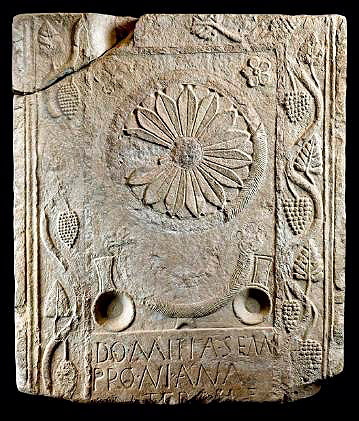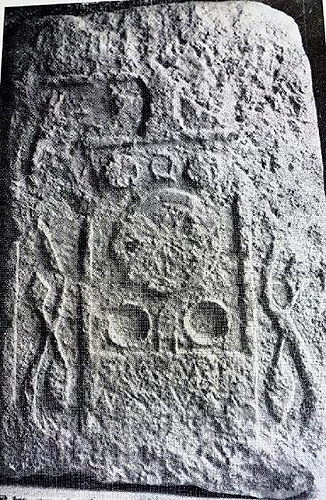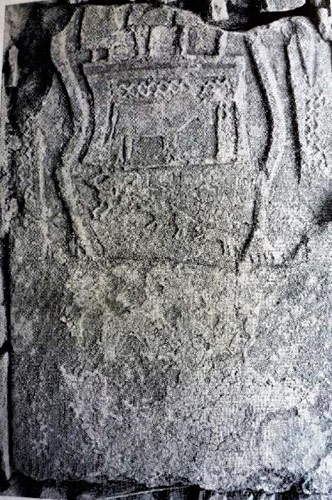The piece of the month of September 2019
EVOCATION OF WINE AND VINES ON ROMAN FUNERARY STELAE IN NAVARRA
Carmen Jusué Simonena
UNED Pamplona
History books tend to focus their attention on great events in which there is hardly any room for everyday activities; however, the apparent insignificance of simple things conceals the prominence that they actually hold. Wine is a good example of this reality; the generalisation of its consumption in classical antiquity turned a simple drink into a bond of union between different peoples and a product with social and economic repercussions B . In the world of theories, there are solid arguments that justify this extraordinary diffusion, although, in the case of alcohol, it is preferable to avoid grand reasons and consider that its popularity is due to the fact that, as the poet Ovid said, "worries flee and are erased with plenty of wine".
Roman art, a faithful representation of the people who produced it, conveys a practical and utilitarian sense and temperament. It is based on the patterns of the Hellenistic schools and is often considered as one of them, although prolonged in time and space, but it nevertheless has an outstanding personality, based mainly on the importance of technique, and reflected fundamentally in architectural works, although with great importance also for the other manifestations, such as sculpture, painting and mosaics.
The presence in this art of grapes, vines, vine shoots, allegorical elements of wine, etc., is constant. Mosaics, decorated funerary stelae, votive altars, some bronze figurines, as well as various reliefs, in addition to the many wine installations, eloquently convey the importance of the vine in this land, either as a decorative element or as a plant expression of immortality, given that the representation of the vine is general throughout the Roman world as a Dionysian symbol of profound eschatology, with a role similar to that of the funeral banquet to translate that wine opens the way to knowledge and eternal happiness.
Motifs of vines, grapes and vine shoots are frequent on some decorated funerary stelae from the Roman period, to such an extent that these plants appear almost exclusively, among Hispanic stelae, on more than twenty examples from Alava and Navarre, whose geographical, thematic and stylistic proximity has been repeatedly highlighted. In them, the plant stems adopt a marginal position, running along the edges of the stele; they have an alternating rhythm, with a vine and a bunch corresponding to each curve. The Gastiain specimens show an invariable arrangement, with the bunches always facing inwards and the veined leaves facing outwards, while the stems start from a container.
The unequivocal significance of these iconographic elements is assured in the pieces flanking an altar at the head of the monument, as well as in the appearance of jars or potsherds in most of the examples, ornamentation similar to that found in the reliefs of the Casquilletes of San Juan de Gallipienzo and in the vicinity of Santa Criz de Eslava.

Relief with figures of vines and grapevines from near the site of Santa Criz de Eslava, similar and identical to those found at Los Casquilletes de San Juan de Gallipienzo, invoice .
From Gastiain there is an important group of decorated funerary stelae that were found embedded in the Shrine of Our Lady of Fair Love of San Sebastián in the town and are currently in the Museum of Navarre. In four of them, the decoration of vines, grapevines and trvllae, together with other decorative elements and interesting inscriptions, form a unitary group in terms of iconographic elements of great interest.
This is the case of the so-called 'Antonia Buturra' stela, of great size (1.56 x .87 x .27 m.) and one of the most splendid examples of the peninsular stelae. With a horizontal top, it presents an arrangement in three zones, surrounding the whole a decoration of branches and clusters in alternating rhythm that start from two recipients at the base of the stone to join at the head flanking an altar. A listel forms the interior rectangle divided by three others in four parts. In the upper part there is a seated female figure under an arch filled with beveled reticulation, resting on columns with bases. The deceased rests her feet on a footstool, at the sides of which there are two palms on a pedestal. In the upper spandrels, two stars inscribed in a circle, next to the initials D. M., and in the lower angles two trvllae that also appear in the other Gastiain stelae and that generally have been described as pateras. According to M.ª Á. Mezquíriz and M. Unzu, the trvlla is a drinking vessel, although it is probable that its primary function was cultic. It is a ladle with a decorated horizontal handle, a thickened rim on the outside, a convex wall and a flat bottom. The foot is annular, as is the rim. They have an elongated handle, trapezoidal in shape, with an incised line following the rim.
Then follows the registration in cartouche with lugs: D(iis) M(anibus) / ANT(onia) BVTVRRA / VIRIATI FILIA / AN(norum) XXX / H(ic).S(ita). Below is a bull to the right, with its head in frontal position between two trees. In the lower segment, a large wheel encloses a rosette of multiple lanceolate petals, with swastikas at the upper corners and, below, two amphorae.

Gastiain. Decorated stela called 'of Antonia Buturra', of great size (1,56 x 0,87 x 0,27 m.) and one of the most splendid
(1.56 x .87 x .27 m.) and one of the most splendid specimens of the
of the peninsular stelae.
The stele known as 'Domitia's', also from Gastiain and, like the previous one and the others, dated to the 1st-2nd centuries, has a figurative upper part with a framework with a plant decoration of branches and bunches of grapes. This motif, as has been mentioned, is particular to this area of Navarre and Alava and has a clear funerary interpretation, given that the cluster is an iconographic element related to Dionysus, and linked to the funerary banquet in which wine opens the way to eternal life. In the centre, the scene is dominated by a disc in the shape of a multipetalous flower, a common motif in Roman contexts, and below it, a lunar crescent with decoration on its tips. On either side of it are two trvllae, generally used in religious rituals. All of these elements - bunches of branches and branches, the sun, the moon and the papyrus - clearly indicate that this is an iconography related to the afterlife. The piece is fragmentary, as the entire lower part is missing. The funerary registration preserves the initial part, which reads Domitia Semproniana Materni f(ilia).

The stele known as 'de Domitia', also from Gastiain and, like the previous stele and the others from that locality, dated to the 1st-2nd centuries, has a figurative upper part, with a framework with a plant decoration of branches and bunches of grapes.
A third example, of the same provenance, preserves only the upper part, with a horizontal top and identical vegetal decoration to the previous ones, with the two leaves of the head facing each other and flanking an altar. In the upper spandrels there are two trvllae, and in the lower ones an amphora on the left and an oinochoe on the right. Between the two, and under the large wheel, there is a bird pecking at a bunch of grapes and another larger bird approaching the oinochoe. The registration follows, in two lines between the lines, with the lower part missing, which must have had a horseman. The registration reads: M.IVNIVS.PATERVS CANTABRI FILIVS AN(norum) XXXX H(ic).S(itus).

Pitchers, trvllae, vines, grapevines..., again the same decoration is repeated on this stele, also from Gastiain.
is repeated on this stele, also from Gastiain.
Opposite them, the fourth stele from Gastiain is poorly preserved. It has a horizontal top and in the central rectangle there is a multipetal rosette inscribed in a wheel, with another two in the upper corners and two trvllae in the lower spandrels. The whole is surrounded by the usual decoration of vine leaves and vine shoots, which are joined at the front flanking an altar. The remains of registration are illegible in their present state.

Despite the deterioration caused by various climatic agents, this stele, also from the town of Gastiain, shows the usual decoration of vine branches and leaves that join together at the front flanking an altar.
Finally, in the town of Iruñuela, another stele is found embedded in the wall at the front of the cemetery that dominates the urban area. An interesting piece without a finial, its decoration is divided into three areas. In the upper one there are three standing figures wearing a talar costume below the knee, and it is impossible to determine their sex or any other detail. In the central part there is a rectangle with a bull inside it. The third area depicts a hunting scene in which a man with a spear awaits the attack of a wild boar being chased by a dog. Between the two animals and the previous rectangle, the remains of the registration: ...HOMICINO.... ASINO AN(norum) ...H(ic) S(itus) E(st) (?). The whole field is framed by two large vine stalks.

An interesting funerary stele from the town of Iruñuela,
Despite its deterioration, it reveals various figures, a hunting scene and large vine stalks.
and large vine stalks.
SOURCES AND BIBLIOGRAPHY
TARACENA, B., VÁZQUEZ DE PARGA, L., "Excavations in Navarre. III. Prospecting at 'El Castellar' in Javier and 'Los Casquilletes de San Juan' in Gallipienzo", Príncipe de Viana, 7, Pamplona, 1946, pp. 9-25.
BLÁZQUEZ MARTÍNEZ, J. M.ª "Reliefs from the 'Casquilletes de San Juan', Gallipienzo", Príncipe de Viana, 22, Pamplona, 1961, pp. 121-126.
framework SIMÓN, F., "Estelas decoradas romanas en Navarra", Trabajos de Arqueología Navarra, 1, Pamplona, 1979, pp. 205-250.
CASTILLO, C., GÓMEZ-PANTOJA, J., MAULEÓN, M. D., Inscripciones romanas del Museo de Navarra, Pamplona, 1981.
MEZQUÍRIZ IRUJO, M.ª Á., UNZU URMENETA, M., "finding de una trvlla en Pompelo", Cuadernos de Arqueología de la Universidad de Navarra, 18**, 2010, p. 301-316.
